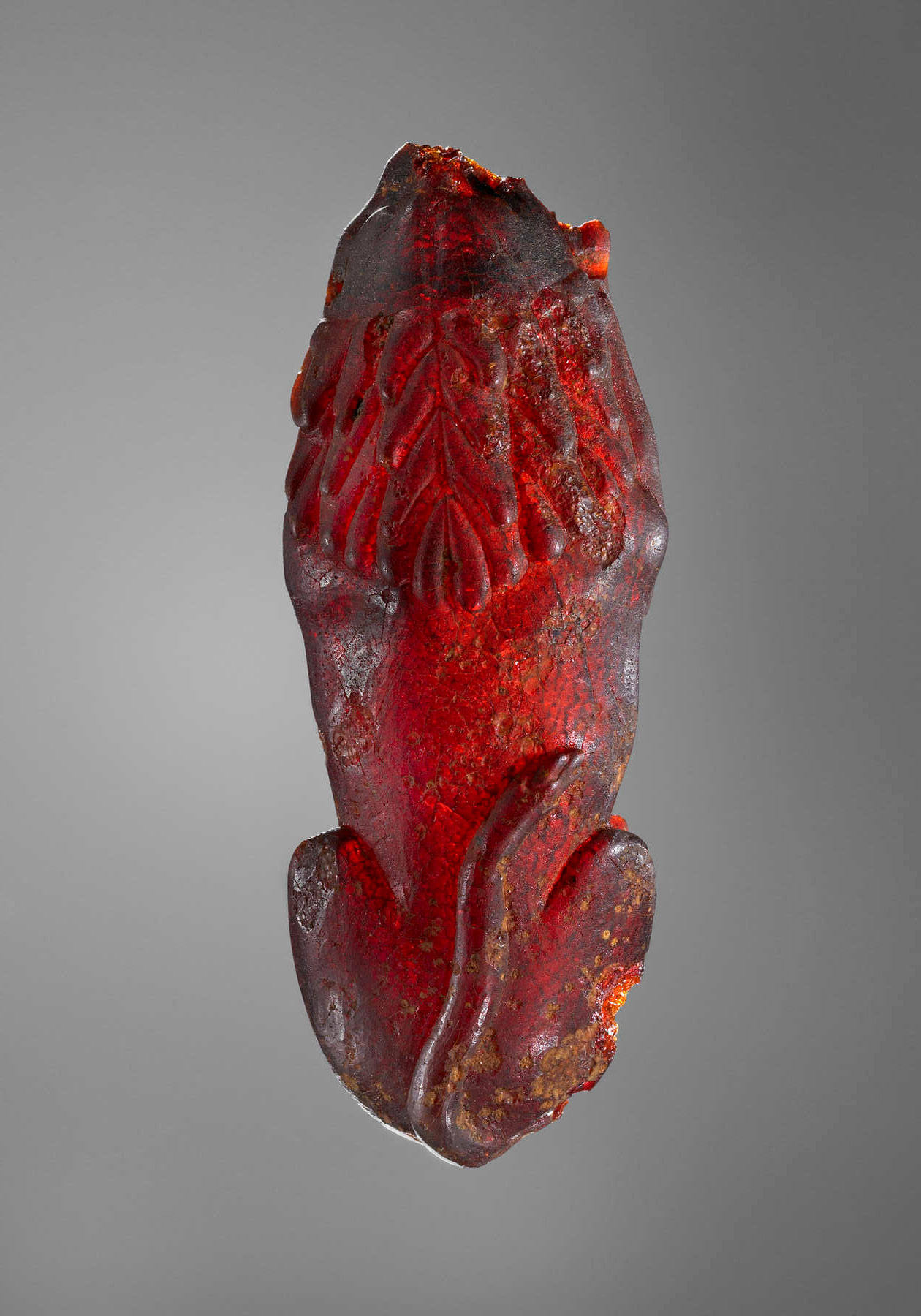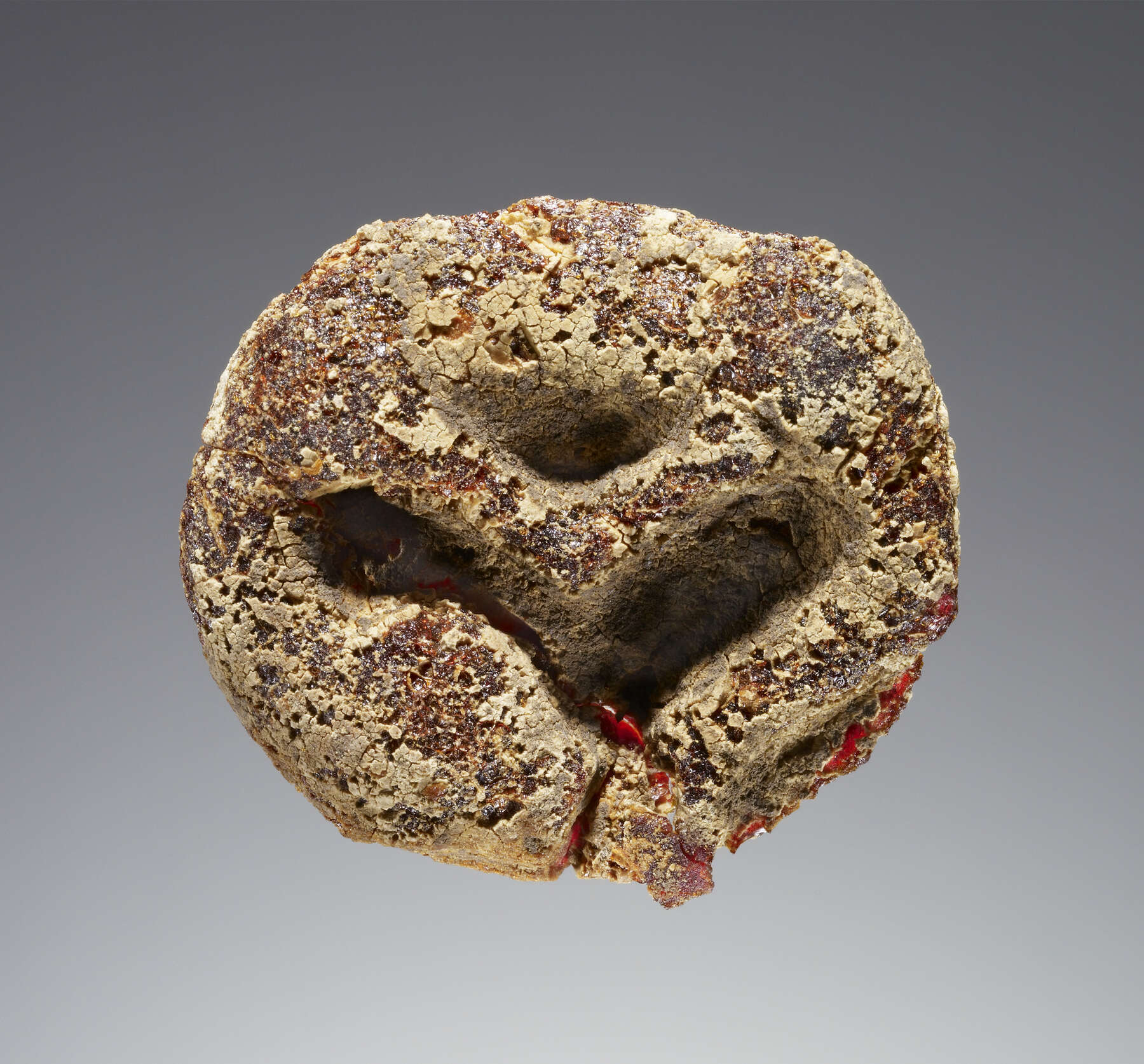32. Pendant: Female Animal (Lioness?)
| Accession Number | 77.AO.81.8 |
| Culture | Etruscan |
| Date | 500–480 B.C. |
| Dimensions | Length: 55 mm; width: 23 mm; height: 23 mm; Weight: 7.2 g |
| Subjects | Animals; Fertility; Inclusions; Lion |
Provenance
–1977, Gordon McLendon (Dallas, TX), donated to the J. Paul Getty Museum, 1977.
Condition
The pendant is intact except for small losses to the left lower jaw and center of the chest. The surface is crazed and cracking, with flakes missing from the cortex. Before entry into the donor’s collection, the pendant was mechanically cleaned and treated with a thickly applied surface consolidant that added shine to the surface. In ambient light, the pendant is light brown, and in transmitted light, red-brown. The untouched surface inside the perforations may indicate the appearance of the amber before treatment.
Description
The original shape of the amber blank may be reflected in the compact, droplike shape of the pendant. The bottom is flat and the top convex, tapering at the nose end. The animal is stretched out, with her open-eyed head placed on her paws. The head and body curve slightly to the right, with the animal’s left shoulder and leg extended farther on the left. The head is square, with a full forehead that gently slopes to the bridge of the nose, a flat muzzle, and a small mouth. The jaws are square. Dividing the head from the body at the thick neck is an engraved line. From it spring two triangular ears. The animal’s back is full and rounded, arching all the way through the lumbar region. The front and back legs have a similar shape. The haunches are drawn forward, with the lower legs next to the abdomen and advanced past the point of the knee to midbody. The back lower legs are comparatively thin and angular, with long, hooklike feet. In comparison, the front feet are small. The left foreleg is farther forward under the head; an object may be held beneath it. The five pairs of large dugs lie in neat rows.
Because of the state of preservation and the chemical treatment of the amber, only the traces of engraved lines are witness to the pendant’s manufacture. A perforation with holes each 2 mm in diameter passes directly under the neck in line with the root of the ears. If suspended by the boring through the head, the animal would have hung head upward; if a suspension device were attached to the holes in the rump, it would have hung nose downward. A pair of stopped bores, each 2 mm in diameter, are located at the sides of the tail, to a depth of about 3 mm. Below the left side of the lower lip is a similar bore, 2 mm in diameter and about 2.5 mm deep.
Discussion
Feline, dog, sow, or hare? The physiognomic characteristics of 77.AO.81.8 are not like those of any other animal, or of any other ancient representation of an animal, known to me. It has no parallels within the corpus of pre-Roman carved amber. Nevertheless, in its general format, 77.AO.81.8 is similar to many other types of amber in the form of dormant animals—for example, (cat. no. 31), to name one Getty pendant. The curve of the upper part of the animal’s body, the short, fat body, and the positioning of the right paws are similar to the features of a group of Orientalizing amber dog pendants1 and to many Archaic amber lions. The ancestral schema of the amber lions may be Mycenaean. 77.AO.81.8 is particularly close to an extant pendant, the gold couchant lion from Tomb 5 at Hagia Triada (circa 1500–1450 B.C.).2 This said, the form of the head and ears, the manner in which the animal crouches, and the dugs invite comparison to a small group of Orientalizing representations of felines. (The legs and feet of 77.AO.81.8, however, are more lagomorphic than leonine.) The short, curled tail is the one big difference between 77.AO.81.8 and and the other related amber felines (as well as the comparable Bronze Age gold lions). Although a few Etruscan felines appear to have short tails,3 the short curly tail of 77.AO.81.8 is more like that of a pig or some breeds of dog, including Canis familiaris Studer, the big, smooth-haired, heavy dog with small ears represented in Mesopotamian art.4
The stopped bores near the jaw area and to either side of the tail are equally without parallel. They were likely used for attachments, perhaps a collar at the neck if the animal is a dog, or for the attachment of pendants (nursing young?). The prominence of the milk-laden breasts of the amber animal emphasizes the fertility and regenerative aspects of the pendant amulet. If it represents a dog, there may have been an association with guardianship, protection, and healing. The ancient Near Eastern association of the dog with Gula, “the great physician,” is allied to the later importance of the dog in the iconography and cult of the healers Apollo Asgelatas and Asclepius.5 Some Egyptian Late Period amulet types of glazed-composition sows (the sky goddess Nut, or Isis?) were intended to endow their wearers with fecundity.6 Comparable are Archaic Etruscan painted representations, such as the felines painted on vases (primarily found in tombs) by the Micali Painter, or the mammiferous feline painted on the walls of the Tomb of the Lionesses at Tarquinia, where the lioness acts not only as mediator but also as nurse.7 Nigel Spivey suggests that the lactating felines of Etruscan funerary art allude to breastfeeding, to the feeding of children, to the infantile condition, and to rebirth, and that the passage to the afterworld is expressed simply by a return to the infantile state.8 J. Bulté shows how in Egypt, images of a lactating lioness (or of a figure with a feline body and a human head) were not uncommon as the subject of faïence (glazed-composition) amulets, which she shows to be associated with happy maternity (“l’heureuse maternité”).9 A lactating feline carved from amber must have been a powerful amulet, one in which the fertility associations and regenerative aspects of the material were enhanced by the subject (especially if the attachments were tiny kittens).
Notes
- For the small amber dogs, see (cat. no. 27). ↩
- Heraklion Museum 140 (from Tomb 5 at Hagia Triada): , p. 65, pl. 5B; and A. Marinatos and M. Hirmer, Crete and Mycenae (London, 1960), p. 48. ↩
- , pp. 176–77. ↩
- D. Bonatz, “Dog,” in Iconography of Deities and Demons: Electronic Pre-publication (last revision November 4, 2008), www.religionswissenschaft.uzh.ch/idd/prepublication_2.php. ↩
- Ibid. ↩
- , p. 35. ↩
- See also A. H. Ashmead, “Etruscan Domesticated Cats: Classical Conformists or Etruscan Originals?,” in , pp. 144–64. ↩
- N. Spivey, “Il Pittore di Micali,” in Il Pittore di Micali, exh. cat. (Rome, 1988), p. 19. ↩
- , pp. 52–55, 84, chap. 7. ↩
Bibliography
- Andrews 1994
- Andrews, C. Amulets of Ancient Egypt. Austin, TX, 1994.
- Brown 1960
- Brown, W. L. The Etruscan Lion. Oxford, 1960.
- Bulté 1991
- Bulté, J. Talismans égyptiens d’heureuse maternité: “Faïence” bleu vert à pois foncés. Paris, 1991.
- De Puma and Small 1994
- De Puma, R., and J. P. Small, eds. Murlo and the Etruscans: Art and Society in Ancient Etruria. Madison, WI, 1994.
- Higgins 1980
- Higgins, R. A. Greek and Roman Jewellery. 2nd ed. London, 1980.



